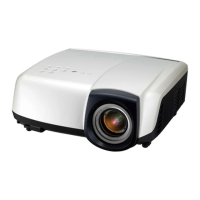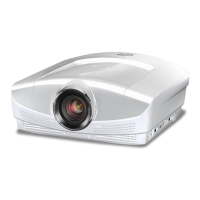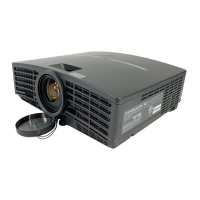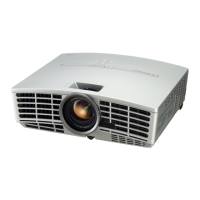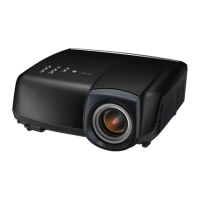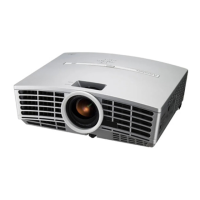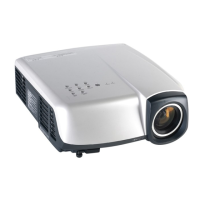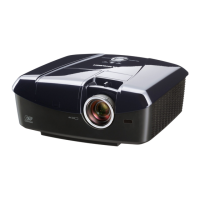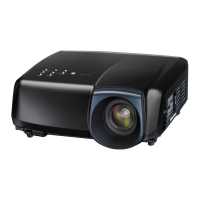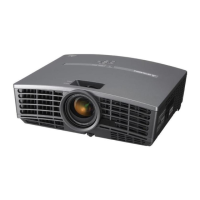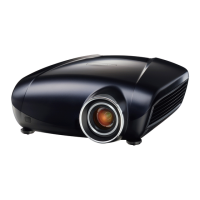
Do you have a question about the Mitsubishi Electric HC6500 and is the answer not in the manual?
| Brand | Mitsubishi Electric |
|---|---|
| Model | HC6500 |
| Category | Projector |
| Language | English |
Safety warnings, regulatory compliance, and important notes for safe operation.
Regulatory compliance statements for European directives and FCC.
Official declarations of product compliance and identification of responsible parties.
Listing of trademarks and registered trademarks associated with the product and its technologies.
Notices regarding compliance with FCC and Industry Canada regulations for digital devices.
Instructions for verifying included accessories and identifying cables and parts.
Step-by-step guide for inserting and removing batteries from the remote control.
Identification of projector parts, external features, and status/power indicators.
Description and labeling of the projector's control panel and input/output terminals.
Identification of the projector's bottom features, including adjustment feet.
Detailed listing and explanation of buttons on the remote control.
Guide to using remote control buttons for adjusting image contrast, brightness, color, and sharpness.
Guidelines for optimal remote control usage distance and environmental factors.
Diagrams illustrating the effective reception angles for the remote control.
Instructions for installing the screen perpendicularly and aligning it with the projector.
Tables and diagrams to determine projection distance based on screen size and aspect ratio.
Detailed tables showing projection distances for various screen sizes and aspect ratios.
Using the Lens Shift function to adjust the vertical and horizontal position of the projected image.
Adjusting projector tilt and using keystone correction to fix skewed or trapezoidal images.
Guidance on addressing fine streaks appearing on projected images.
Using the keystone adjustment feature to correct geometric distortion.
Considerations and settings for ceiling or rear projection setups.
How to use the trigger terminal to control external devices like electric screens.
General instructions for connecting video sources to the projector.
Ensuring power is off for projector and video equipment before making connections.
Diagram illustrating a basic home theater system connection with various video devices.
Instructions for connecting video players using composite or S-video cables.
Guide for connecting DVD players or HDTV decoders using component video inputs.
How to connect video equipment with HDMI output for high-quality images.
Diagram showing the physical connection of an HDMI source to the projector.
Procedures for connecting the power cord and essential safety precautions related to power supply.
Steps to start projecting images, including lamp warm-up and initial setup.
Actions to take before starting the projection process, such as removing lens cap.
Step-by-step guide on how to safely turn off the projector and cool down the lamp.
Options and guidance for adjusting the image aspect ratio to match the input signal and screen.
Instructions for connecting the projector to a desktop computer using RGB cable.
Ensuring power is off for projector and computer before connecting.
Explanation of the DDC1/2B and DDC2B standards for computer communication.
Guidance on connecting the power cord, referencing the video image section.
Steps to start projecting images from a computer.
Actions to take before projecting computer images, like removing lens cap.
Using the auto position button to optimize image display from a computer.
Considerations and procedures for connecting notebook computers.
Guidance on matching computer and projector resolutions for optimal display.
Main menu category for image-related settings like contrast, brightness, and color.
Main menu category for projector installation settings like keystone and lamp mode.
Main menu category for feature settings like aspect ratio and input selection.
Main menu category for signal input adjustments and video format settings.
Main menu category for displaying operating status like lamp time and input signal details.
General guide on how to navigate and change settings within the projector menus.
Detailed explanation of settings available within the Image menu.
Detailed explanation of settings available within the Installation menu.
Detailed explanation of settings available within the Feature menu.
Detailed explanation of settings available within the Signal menu.
Detailed explanation of settings available within the User menu.
Details on displaying operating status like lamp time and input signal.
How to save and recall image quality settings using AV memory slots.
Procedures for modifying image brightness and contrast using menu options.
Procedures for modifying image color saturation and tint using menu options.
How to adjust the sharpness of the projected image using the menu.
Customizing the white tone by selecting preset color temperatures or user-defined values.
Using the Auto Iris function to automatically adjust contrast based on image content.
Fine-tuning gamma curves for brightness levels to optimize image gradation.
Applying noise reduction filters like TRNR, MNR, and BAR for cleaner images.
Troubleshooting common computer image display issues and menu adjustments.
Methods for easily adjusting the horizontal and vertical position of projected images.
Guidance on enabling the LPF filter to reduce streak noise in projected images.
Features for security, including password protection for display input or menu access.
Information on using the Kensington Security Standard connector for physical security.
Information on when to replace the projector lamp based on operating hours and indicators.
Step-by-step guide for safely removing and installing the projector lamp.
Instructions for resetting the lamp operating time counter after replacement.
Specific instructions for safely removing the lamp when the projector is ceiling-mounted.
Procedures for cleaning the projector's air filter to ensure proper ventilation.
Guidelines for cleaning the projector body, ventilation slots, and grilles.
Instructions for safely cleaning the projector lens using appropriate materials.
Common problems related to the projector not turning on and their solutions.
Troubleshooting steps for when no image appears on the screen.
Troubleshooting steps for common image quality issues like flickering and displacement.
Addressing issues such as color tints, afterimages, dots, streaks, and wavy images.
Resolving miscellaneous problems like menu unresponsiveness or mechanical noise.
Troubleshooting common problems that occur after the lamp has been replaced.
Explanation of the power and status indicator lights during normal operation.
Interpretation of indicator lights during abnormal conditions and suggested solutions.
Details on the display technology, resolution, and projection lens specifications.
Specifications for the projector lens and the light source lamp.
Information on supported computer and video input signals and their terminal types.
Technical data on the projector's size, weight, operating conditions, and power consumption.
Detailed table of supported RGB signal modes, resolutions, and frequencies.
Pin assignments for serial, computer, and HDMI connectors.
Information on optional replacement parts like spare lamps and filters.
Contact details for warranty, sales, and technical support in North America.
Contact details for warranty, sales, and technical support in Europe.
Contact details for warranty, sales, and technical support in Asia.
Contact details for warranty, sales, and technical support in Oceania.
